A Rare Peek Inside the Vast Right-Wing Conspiracy
The Council for National Policy, a secretive network of powerful conservatives, goes to great lengths to conceal its activities and even its members. But recently uncovered documents reveal the extent of the group’s influence on American politics.
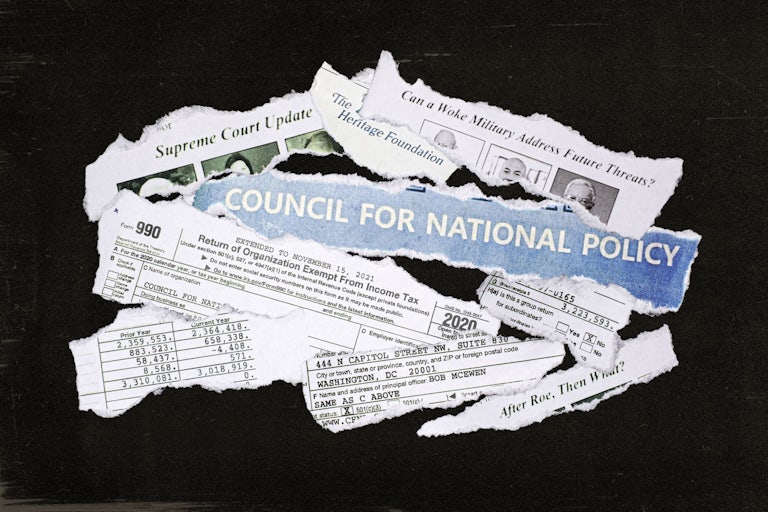
ILLUSTRATION BY THE NEW REPUBLIC
Anne Nelson/August 26, 2022
For more than four decades, the Council for National Policy, or CNP, has functioned as the secret hub of the radical right, coordinating the activities of right-wing strategists, donors, media platforms, and activists. Its membership and meetings have long been undisclosed, but over the past two years, a number of them have been brought to light. It has spawned generations of offshoots, which appear, disappear, alter URLs, and change names with astonishing frequency. Now two watchdog organizations have obtained new materials on the group’s current operations.
The Center for Media and Democracy has published the agenda for a recent CNP meeting, held February 22 to 24 at the Ritz-Carlton in Laguna Niguel, California. In addition, Documented, an investigative watchdog and journalism project based in Washington, D.C., has obtained the membership roster and most recent 990 tax filings required of nonprofit organizations. Together, the materials shed new light on the CNP’s role in disrupting the democratic process. CNP archives illustrate the extensive planning its members undertook to discredit the 2020 election results, undermine local election officials, and incite the protest on January 6, 2021. The House select committee on January 6 has subpoenaed CNP election expert Cleta Mitchell, and the panel is also examining 29 texts exchanged between then–White House chief of staff Mark Meadows and Supreme Court spouse Ginni Thomas (a board member of the CNP’s lobbying arm) in support of Donald Trump’s attempts to overturn the election. The Conservative Partnership Institute, which has attracted ample attention for its role in election subversion, is closely tied to the CNP, though few reporters have made the connection. The CPI’s chairman, president and CEO, senior legal partner, and senior director of policy are all prominent members of the CNP (see below), and the CPI has served as a public face for CNP tactics developed behind closed doors.
Until now, the most recent CNP membership roster that was publicly available was dated October 2020. One can observe significant turnover from meeting to meeting, while various core donors and leaders remain constant. Reading the tea leaves, this shift suggests several possibilities. First, the rosters may indicate only the attendees of a particular meeting, while the broader membership might be much larger. Second, the new names on the February 2022 agenda may represent new approaches for the organization’s strategy. Below, I draw attention to some of the more striking developments in CNP’s leadership and membership, in the agenda, and in CNP’s funding.
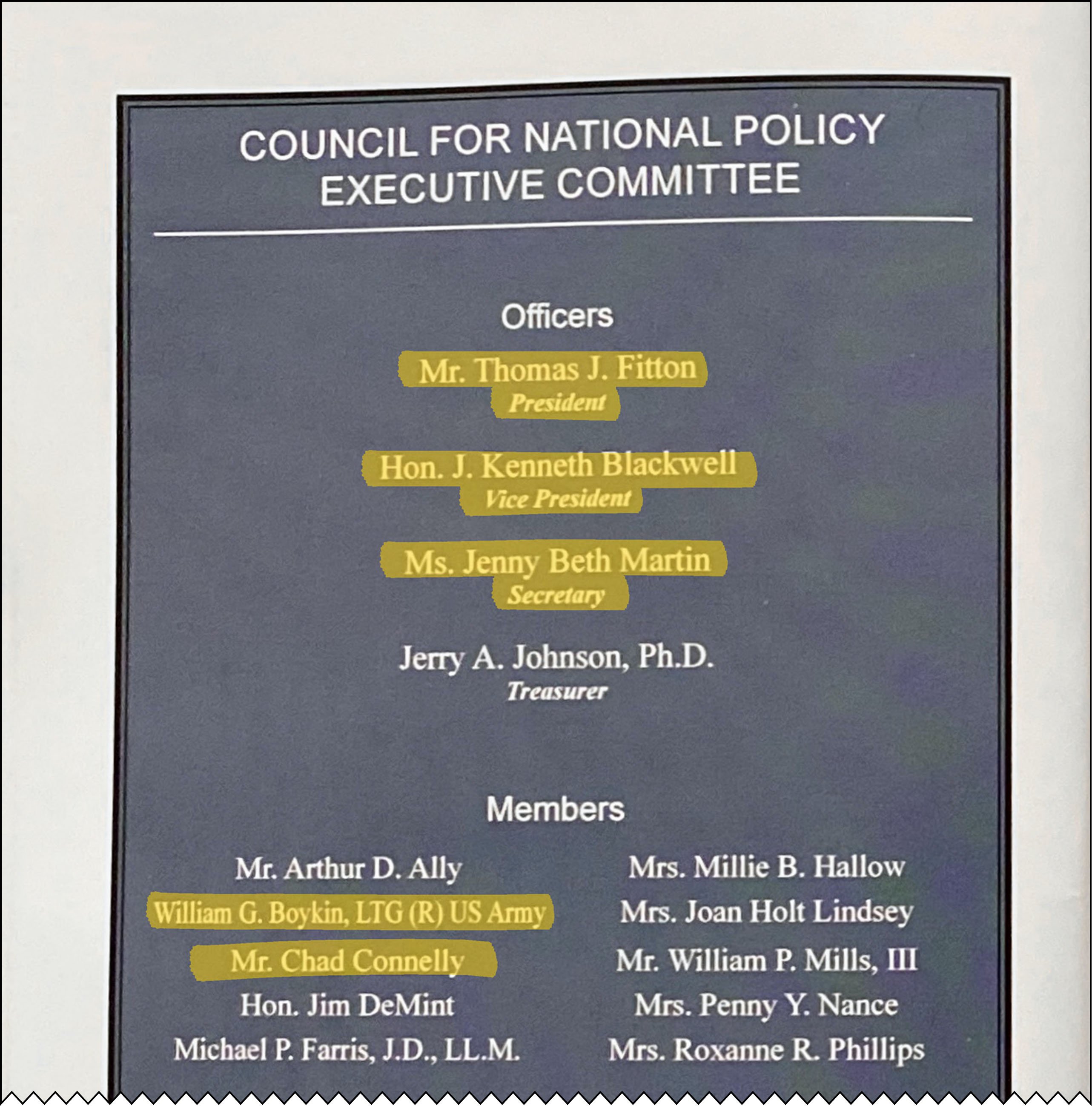
The February meeting brought a new slate of officers, including incoming president Thomas Fitton, the head of Judicial Watch. Fitton’s organization specializes in “carpet-bombing” (in the words of The New York Times) the federal government with Freedom of Information Act lawsuits. In the past, the CNP presidency has corresponded to the group’s short-term priorities. For example, during the 2016 campaign, Family Research Council president Tony Perkins led a drive to bring fundamentalist support to Donald Trump. In 2020, his successor, financier William Walton, conspired with the Trump campaign to reopen the economy prematurely at the height of the Covid-19 epidemic. As president of Judicial Watch, Fitton has promoted false claims about climate change, voter fraud, Hillary Clinton’s emails, and the Mueller investigation. In October 2020, Trump appointed him to the D.C. Commission on Judicial Disabilities and Tenure, where he is slated to serve until 2025. His CNP presidency corresponds with the organization’s full-court press on the legal front, reflected in the agenda items on the federal courts and Roe v. Wade.
The CNP’s new slate also includes Ken Blackwell’s promotion to vice president. Jenny Beth Martin, who publicized and took part in the January 6 protest, was named secretary. The new members of the board of directors include retired U.S. Army Lt. Gen. William G. “Jerry” Boykin, a noted Islamophobe and the CNP’s de facto spokesman on military affairs, and Chad Connelly, who was appointed by CNP Gold Circle member Reince Priebus as the first-ever national director of faith engagement for the Republican National Committee from 2013 to 2016.

The Heritage Foundation, a meeting sponsor, has been a core partner of the Council for National Policy from the start, and Heritage president Kevin Roberts is on the CNP board of governors. Roberts was previously the CEO of the Texas Public Policy Foundation, which received funding from Koch Industries and other fossil fuel interests. Roberts’s series of op-eds for the Washington Examiner represent a virtual roundup of CNP talking points, including attacks on “critical race theory,” Black Lives Matter, and climate policy. The Heritage Foundation was co-founded in 1973 by Paul Weyrich, in tandem with the American Legislative Exchange Council, or ALEC; he would co-found the CNP in 1981. Together, the organizations would serve as a three-legged stool for the right, with Heritage as the think tank; ALEC as a state-level “bill mill”; and the CNP as a coordinating body for donors, media, and activists. Here we see the Heritage Foundation supporting a meeting to facilitate the endless round-robin of tax-exempt political activism on the part of these donors (who also fund the Heritage Foundation).
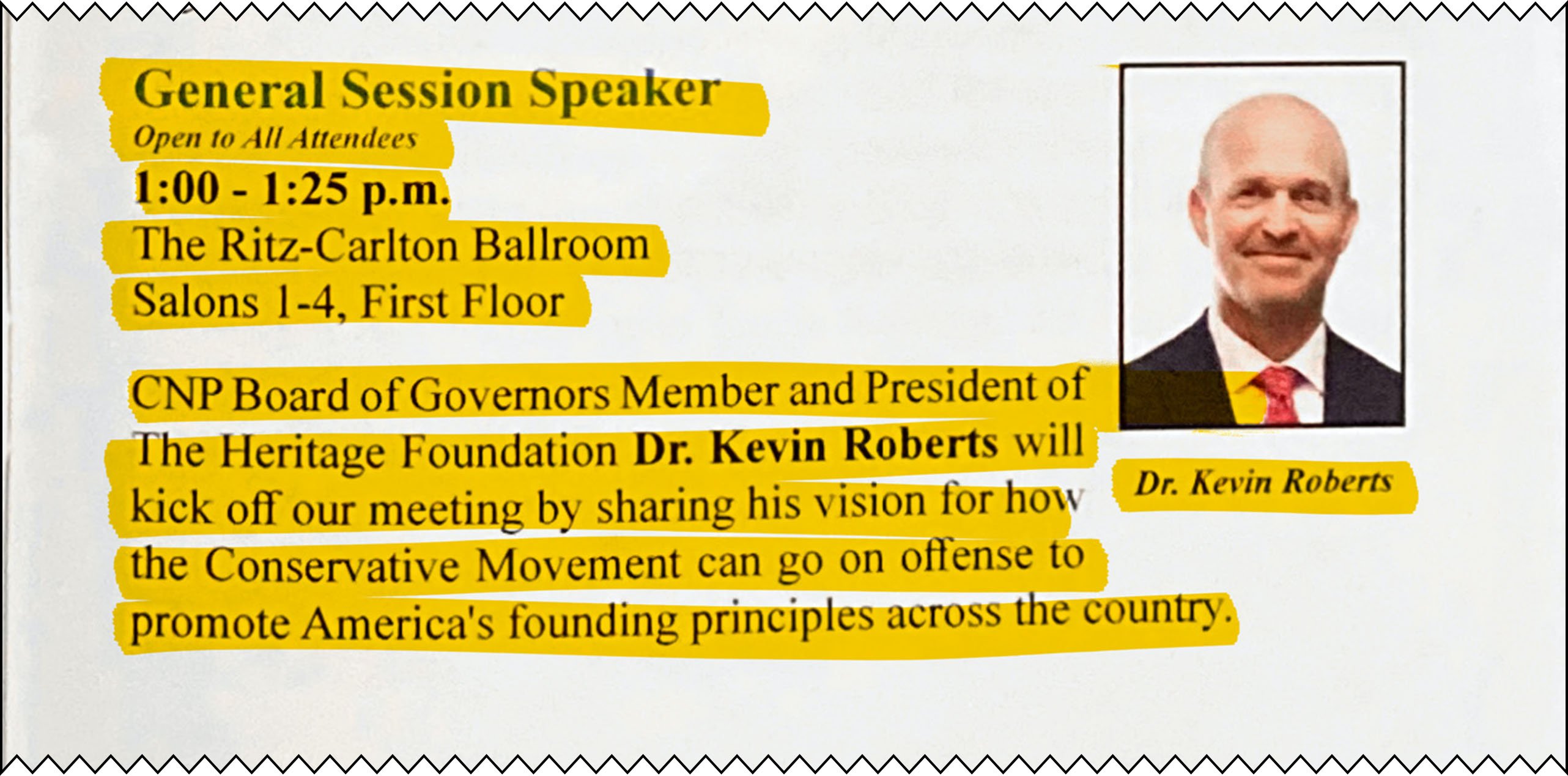
Glenn Youngkin’s 2021 election as governor of Virginia was a major win for the GOP. CNP partners played a significant role in fomenting the “critical race theory” controversy that disrupted school boards and swayed white female suburban voters. In this panel, CNP member Chris Wilson offers his expertise in research, analytics, and psychographics. Wilson had brought Cambridge Analytica in to work on Donald Trump’s 2016 presidential campaign. He appears along with Chad Connelly, a new CNP board member (see above). This general session of the CNP analyses the Virginia victory, followed by an action session with a repeat appearance by Connelly and Wilson called “From Virginia to the Mid-Terms” to “chart the course to success nationwide in November”. Several CNP partners, among them the Leadership Institute and the Family Research Council, have been holding national training sessions on school board activism; Turning Point USA, run by CNP member Charlie Kirk, placed Alexandria, Chesapeake, Loudon County, and other Virginia public schools on its School Board Watchlist.


This panel features new board member retired Lt. Gen. William Gerald “Jerry” Boykin, former head of the Army Special Forces Command (Airborne) and current executive vice president of the Family Research Council, a core partner of the organization (see above). A born-again Christian, Boykin has sparked past controversies with anti-Muslim remarks. He is a frequent guest on Fox News, as well as the Family Research Council’s Washington Watch and other right-wing media outlets. In April and May 2021, Boykin joined several hundred retired high-ranking officers as a signatory to letters supporting Trump’s false claims of election fraud. He continues to serve as a critical link between Christian fundamentalists and the military elite.

Although David Barton hasn’t shown up on CNP rosters so far, the organization takes his revisionist history of the United States as gospel. Barton, who holds a degree in religious education from Tulsa’s Oral Roberts University, has published a long list of books claiming that the U.S. was founded as—and remains—a “Christian nation.” His arguments are used to justify the CNP’s drive for theocracy, which posits that the fundamentalists’ direct line to God entitles them to lord over the rest of us, on matters ranging from abortion to guns. But these eternal verities are established by disregarding the historical research of the past century. For example, Barton has falsely claimed that the Constitution—a secular document that makes no mention of Christianity—is studded with biblical quotations. He presents Christopher Columbus as a savior to the native peoples of the Caribbean (Columbus actually kidnapped and enslaved them), and he overlooks the explorer’s introduction of African slavery to the Americas. Barton’s publisher had to recall his book on Thomas Jefferson based on its errors (after it had already made the New York Times bestseller list)
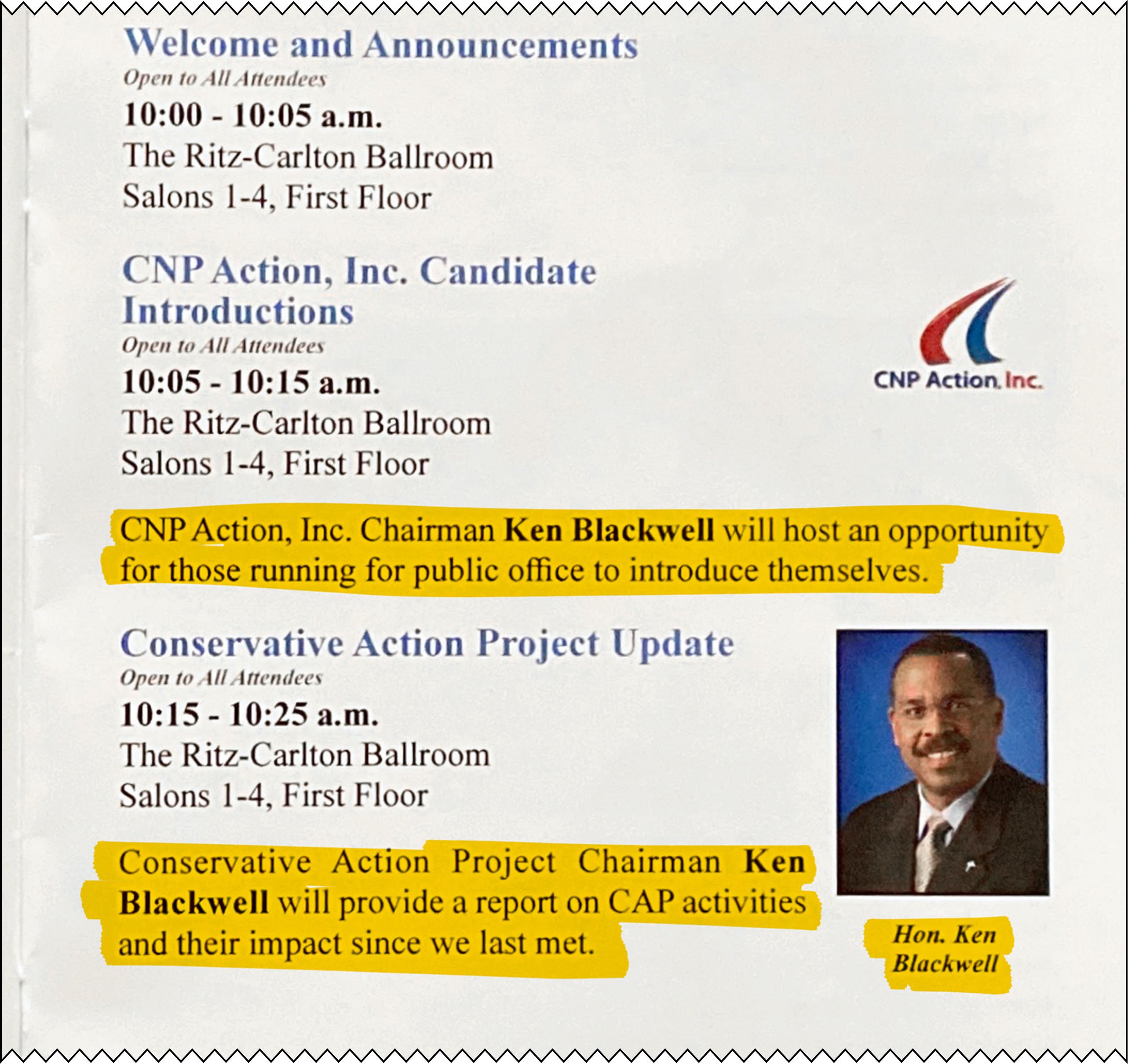
Ken Blackwell serves alongside Ginni (Mrs. Clarence) Thomas on the board of CNP Action, the CNP’s lobbying arm, which has taken a keen interest in election mechanics. Blackwell tirelessly manipulated state-level elections in his native Ohio for over two decades. In 2000, he oversaw the electoral process as Ohio’s secretary of state—at the same time he chaired the Bush-Cheney campaign committee. The Brennan Center found “he issued a series of decisions that both restricted access to voting … and invited criticism for the appearance and substance of partisanship.” He currently serves as the Family Research Council’s senior fellow for human rights and constitutional governance. As of 2022, he has been promoted to chairman of CNP Action.

Alan Sears, Marjorie Dannenfelser, and Kelly Shackelford, the speakers for the first panel, have led the charge on the CNP’s assault on abortion rights. Sears is the founder of Alliance Defending Freedom; Shackelford, until recently the chairman of CNP Action, heads the Texas-based First Liberty Institute, which specializes in litigation on behalf of Christian fundamentalists seeking to expand their claim to the public sphere. CNP Gold Circle member Dannenfelser is president of Susan B. Anthony Pro-Life America (until recently the Susan B. Anthony List), an astroturf organization that coordinates state-level anti-abortion strategies and conducts deep canvassing in key races. Here, the three tee up for the Supreme Court case in which a majority of justices are apparently gunning to overturn Roe v. Wade. The second panel presents Dannenfelser along with experts on “messaging, state legislation, and more.”
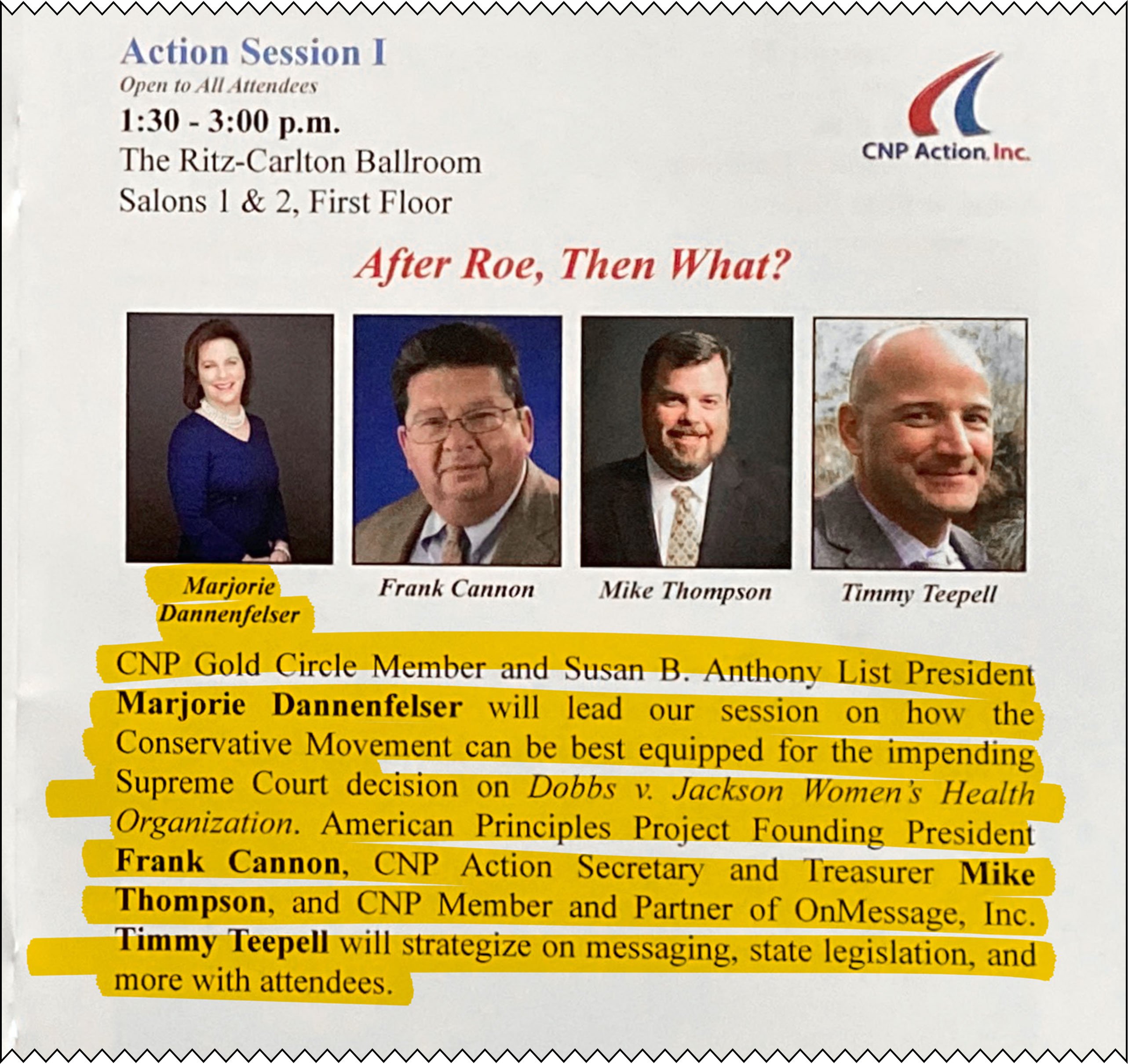
Bhattacharya, a Stanford University School of Medicine professor, was a co-author of the Great Barrington Declaration, an October 2020 open letter that argued against Covid-19 lockdowns and other public health measures. It was produced at the American Institute for Economic Research, which has received funding from Koch foundations. The CNP has been supporting an extensive Covid disinformation campaign over the past two years, attacking the Centers for Disease Control and Prevention and Dr. Anthony Fauci, discouraging vaccination, and promoting the fake “cures” of hydroxychloroquine and ivermectin.

At first glance, the CNP and its lobbying arm, CNP Action, appear to be relatively modest operations. The Council for National Policy’s 990 tax form for 2019, the most recent available, reports a total revenue of about $3.3 million, based on $2.36 million in contributions and $884,000 in program services. CNP Action’s 990 from 2020 reported a total revenue of $121,232, made up of about $88,000 in contributions and $33,200 in program services. But the two organizations’ principal function is to serve as coordinating bodies for their partner organizations, and thus they leverage electoral and legal operations in the hundreds of millions.
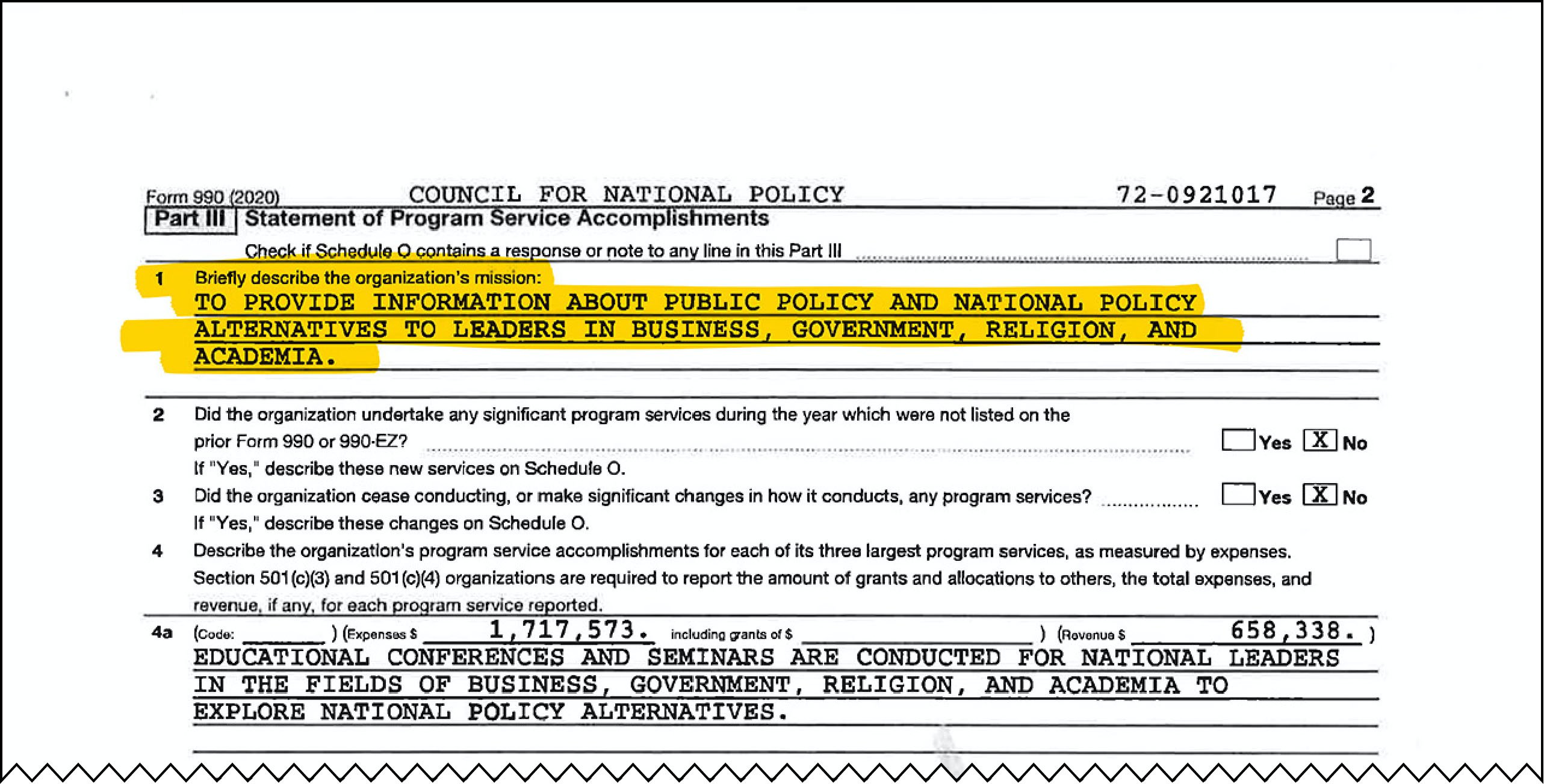
The CNP’s 990 from 2019 states that its purpose is “to provide information about policy alternatives” as a 501(c)3 tax-exempt organization. Under this status, granted by the IRS, the CNP, according to the IRS Code, is “absolutely prohibited from directly or indirectly participating in, or intervening in, any political campaign on behalf of (or in opposition to) any candidate for elective public office.” However, records from recent meetings, accessed by the Center for Media and Democracy, reveal voter-suppression efforts that clearly favor Republican candidates over Democrats. At a May 2019 meeting, Ginni Thomas led a session outlining media and electoral strategies to “protect President Trump.”

The CNP’s 2020 financial statement shows relatively modest gross receipts that emphasize its role as a coordinator for donors and partner organizations and a wielder of influence, rather than an activist body itself. Past CNP documents indicated that members paid between $1,000 and $5,000 in fees, which accounted for a substantial portion of the budget.

The CNP is not required to reveal its donors, but some have listed their contributions on their tax filings. These include the Lynde and Harry Bradley Foundation, headed by CNP board of governors member Richard Graber ($75,000 in 2019); Shackelford’s First Liberty Institute ($37,000 in 2019); and the National Christian Charitable Foundation ($52,600 in 2019). The National Christian Charitable Foundation is a dark money, donor-advised fund, and the sixth-largest charity in the nation. Its donors include various parties connected to the CNP, including the DeVos family of Michigan, the Anschutz fossil fuels dynasty, and the family of the late financier Foster Friess.
While CNP directors are unsalaried, they are often handsomely compensated by the partner organizations themselves. Judicial Watch, for example, paid CNP president Tom Fitton $382,215 in 2019, while Jerry Boykin earned $178,840 as executive vice president of the Family Research Council in 2020 (the most recent years for which filings are available).
The Heritage Foundation offers a recent example of how the round-robin funding works. Heritage is listed as one of the sponsors of the 2022 CNP meeting. It has also received major funding from the Bradley Foundation, the DeVos Family, and Donors Trust, all founded or run by leading members of the CNP. On June 1, the Heritage Foundation announced its inaugural Innovation Prize to “financially support organizations providing innovative solutions to the most pressing issues facing America.” The $100,000 awards went to the Alliance Defending Freedom, headed by CNP board of governors member Michael Farris; the Independent Women’s Forum, headed by CNP Gold Circle member Heather Higgins; and the State Financial Officers Foundation, which organizes state treasurers and auditors in the interest of private enterprise. Its board of directors includes longtime CNP member Lisa Nelson, CEO of ALEC.

Additional donors were named for the CNP’s fortieth anniversary celebration, including Paige Patterson, who was recently named in a report commissioned by the Southern Baptist Convention as one of the senior church leaders who “protected or even supported abuses” in the denomination’s ongoing sexual abuse scandals.
Notable New members, 2020–2022:
The biggest development in the CNP membership is the addition of two dozen medical professionals. Two of the physicians, Simone Gold and James Todaro, have been active in the America’s Frontline Doctors campaign, orchestrated by the CNP and the 2020 Trump campaign, to downplay the Covid-19 crisis, discourage vaccinations, and peddle the bogus “cures” of hydroxychloroquine and ivermectin. Gold and her associates operated a lucrative online prescription service as she awaited sentencing for her illegal incursion into the Capitol during the January 6 riot. Another addition of note is Seymour H. Fein, M.D., who heads CNF Pharma, a pharmaceutical firm based in New City, New York.

J. Christian Adams (new), president, Public Interest Legal Foundation
Adams is an associate of Cleta Mitchell, the CNP attorney who guided efforts to subvert the 2020 election, at the Public Interest Legal Foundation: Adams is president and general counsel, Mitchell is chair, and John Eastman, who drafted Trump’s failed plan to block congressional certification of the 2020 election, is a director. In late 2021, Adams, Trump’s appointee to the Civil Rights Commission, successfully nominated Mitchell to the Advisory Board of the Election Advisory Commission, despite widespread protest.
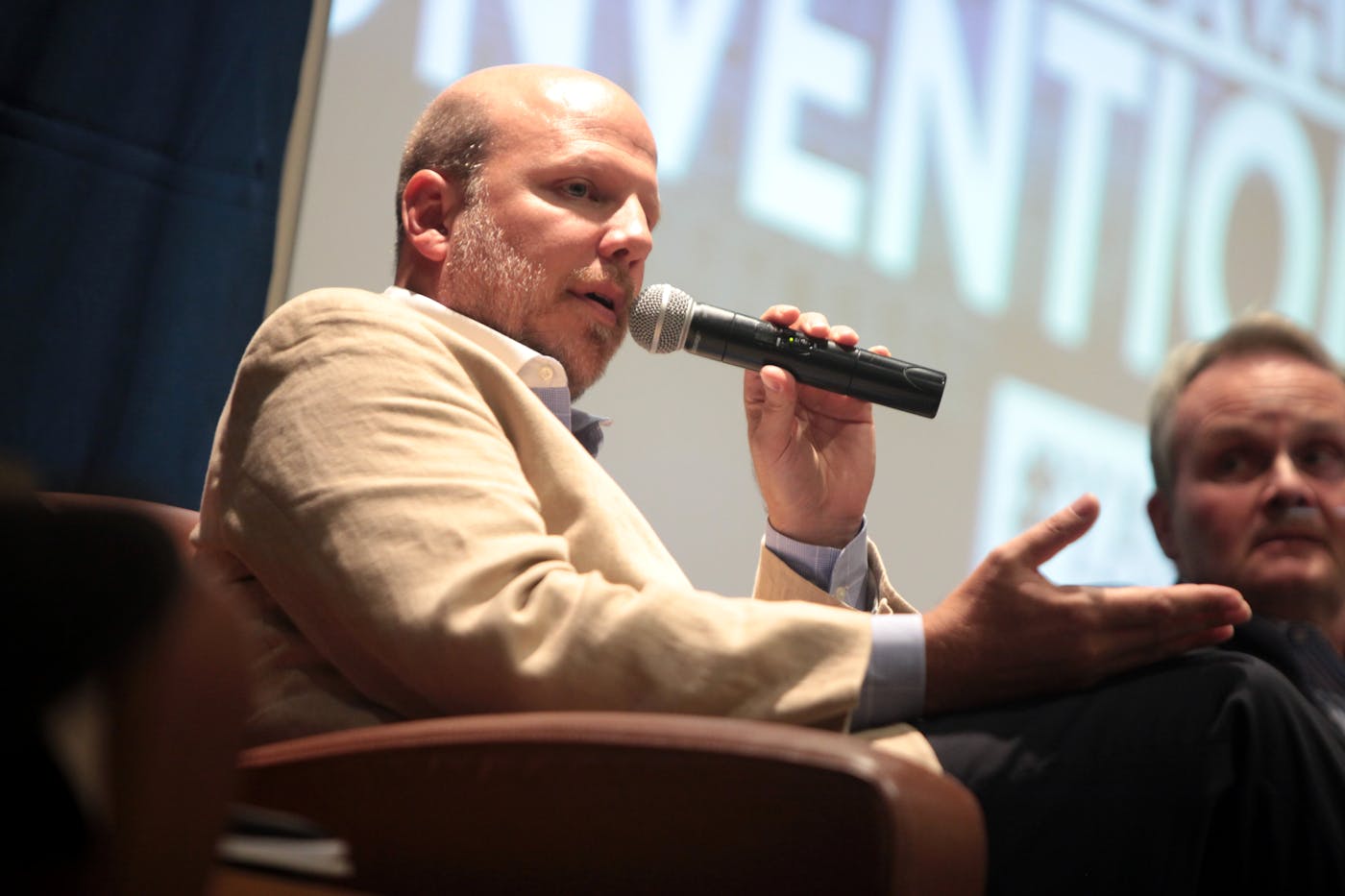
GAGE SKIDMORE:CC BU SA 2.0
Lawson Bader, president, DonorsTrust and Donors Capital Fund
DonorsTrust and Donors Capital Fund are linked dark money, donor-advised funds. DonorsTrust had revenues of nearly $202,800,000 in 2018. Donors Capital Fund’s revenues peaked in 2016, at over $71 million. Major donors include the Koch brothers and CNP affiliates the Bradley Foundation and the DeVos family. Recipients include the National Rifle Association, the Federalist Society, the Heritage Foundation, and ALEC—all run by members of the CNP
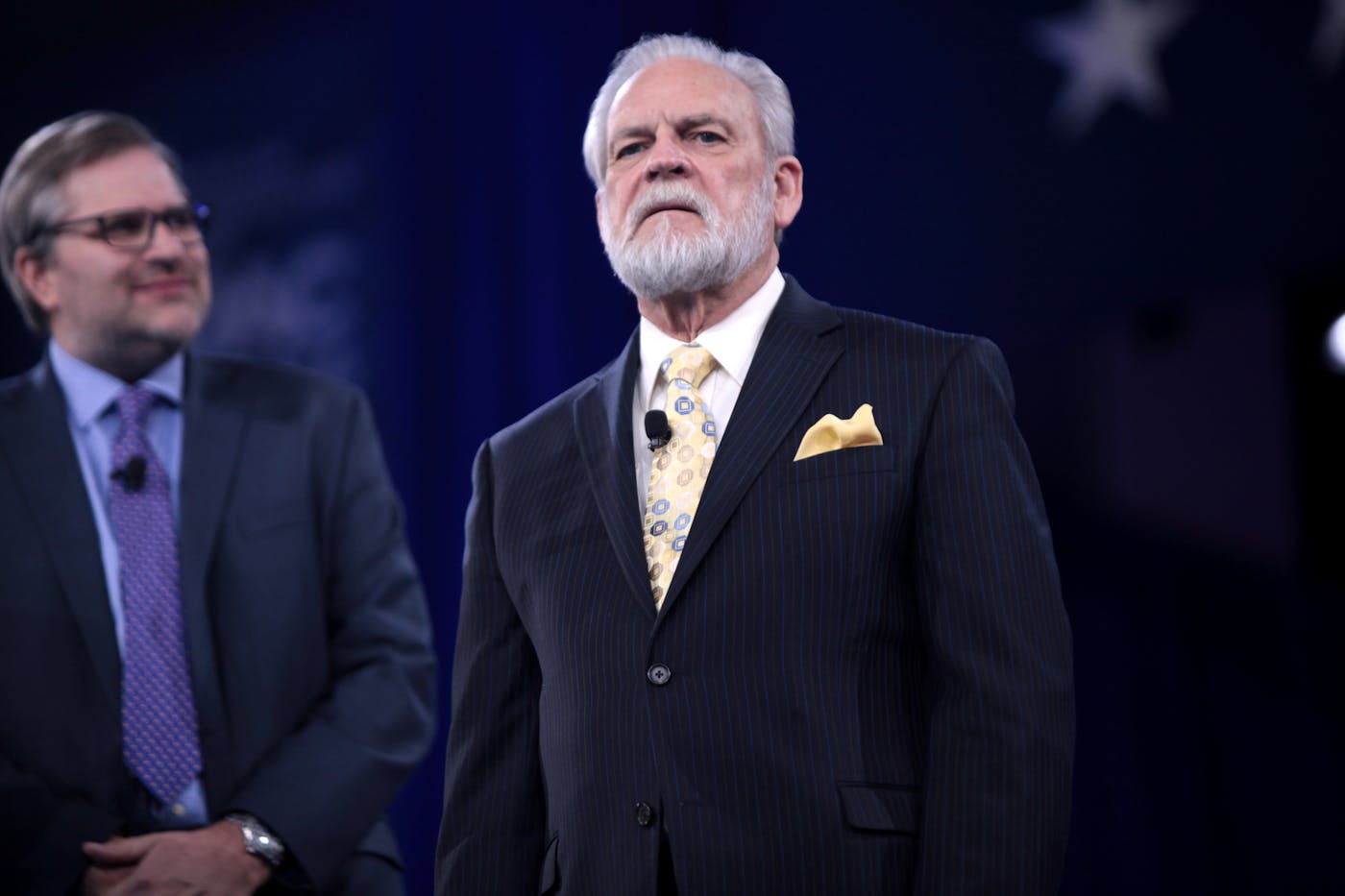
GAGE SKIDMORE:CC BU SA 2.0
Larry T. Beasley, CEO, The Washington Times
In 2015, Beasley was appointed to the board of directors of the American Conservative Union by chairman Matt Schlapp, later a leading election denier.
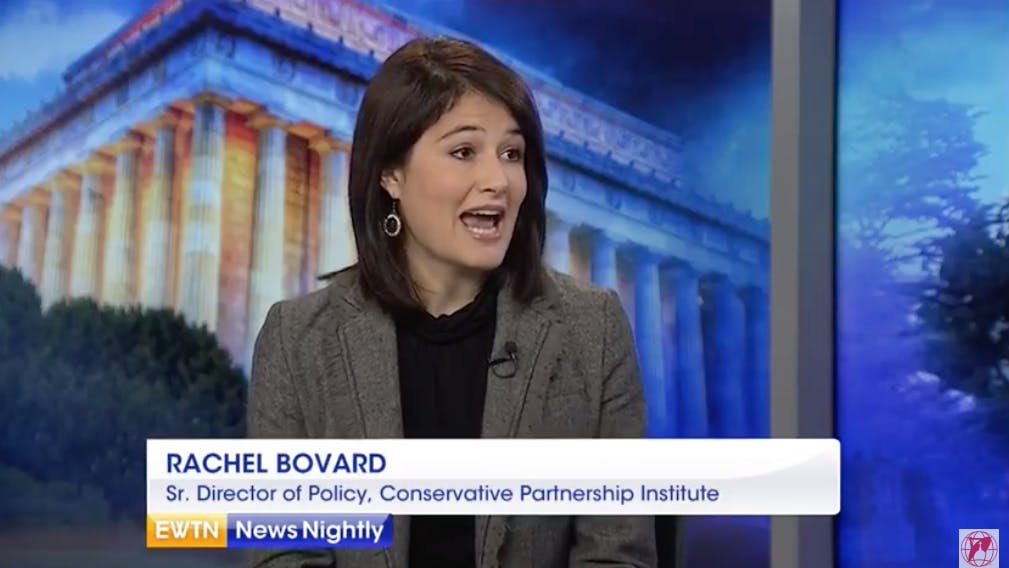
Rachel A. Bovard, senior director of policy, Conservative Partnership Institute
The Conservative Partnership Institute has held statewide voter-suppression summits in key battleground states through its Election Integrity Network, chaired by Cleta Mitchell. The CPI is chaired by former U.S. senator and longtime CNP member Jim DeMint. Its president and CEO is CNP member Ed Corrigan, and its senior legal fellow is the CNP’s Cleta Mitchell. In January 2021, DeMint hired Trump’s former White House chief of staff Mark Meadows, and in July—a week after the House voted to establish the January 6 commission—Trump’s Save America PAC contributed $1 million to the organization.
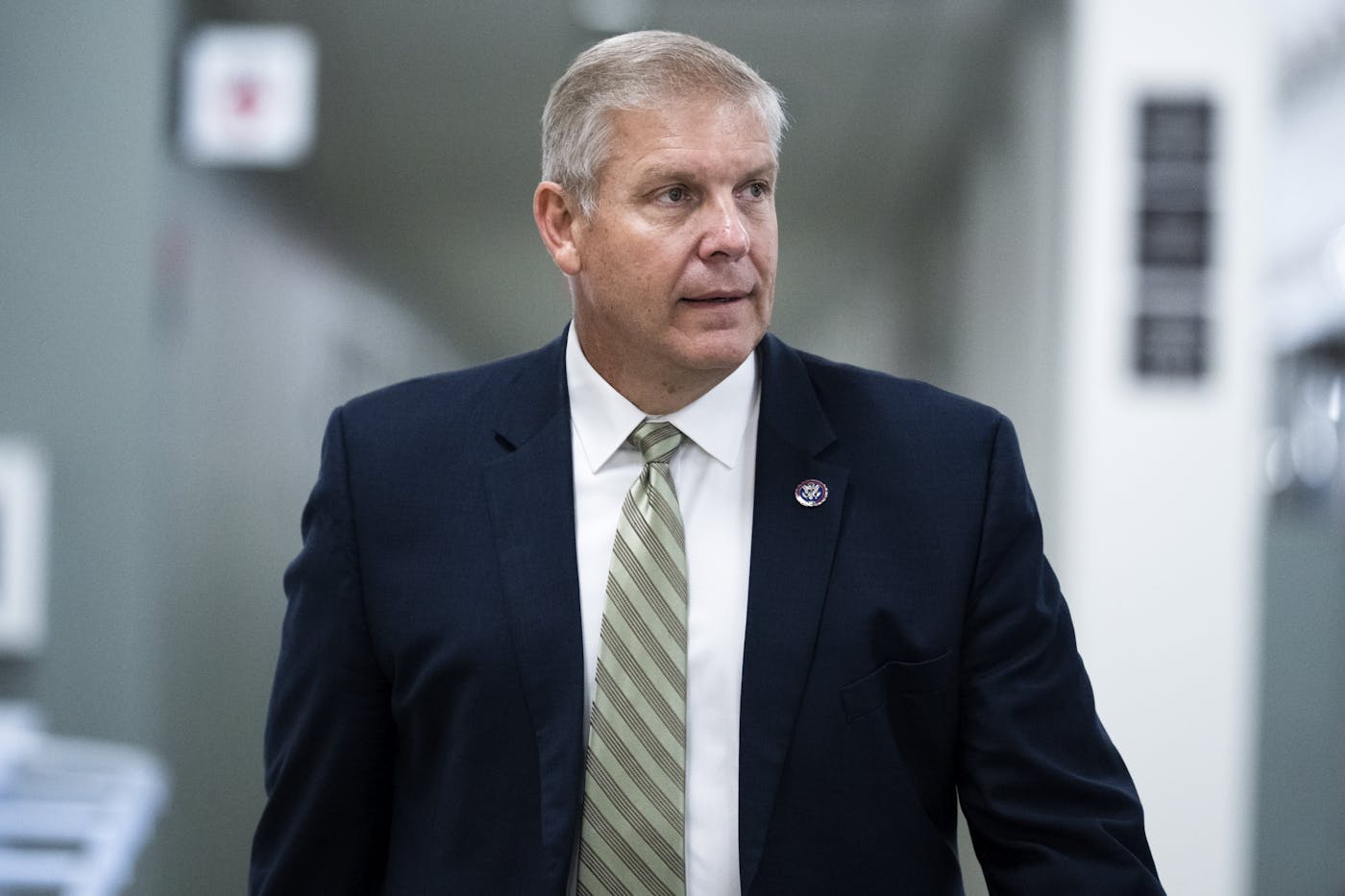
In 2019, Loudermilk compared Trump’s first impeachment to Christ’s crucifixion. A dogged election denier, Loudermilk has admitted to leading a tour of the Capitol on January 5, 2021

TRISTAN WHEELOCK/BLOOMBERG/GETTY IMAGES
Cory Mills, Republican nominee for Congress, Florida, 7th district (Orlando)
Mills, a veteran of the 82nd Airborne Division, has released an online ad based on PACEM Solutions, a company he founded and chairs, which produces “riot control munitions for law enforcement.” His ad, for which he has scheduled a “six-figure” television buy in Orlando, shows video footage of police using tear gas against “Hillary Clinton protesters,” “Black Lives Matter protesters,” and others. On August 23, Mills won the GOP primary, and according to Politico he is favored in the November general election due to a “controversial new congressional map championed by Gov. Ron DeSantis.” Politico predicts that the new map could raise the Republican margin in the state from 16-11 to 20-8 in the next Congress.

C-SPAN/YOUTUBE
Carrie Campbell Severino, president, Judicial Crisis Network
Severino has long been featured as a legal expert on CNP-linked media, such as Tony Perkins’s Washington Watch broadcast. A former clerk for Clarence Thomas, Severino convened a “war room” of Catholic and CNP organizations after the death of Ruth Bader Ginsburg to defend Trump’s ability to appoint a justice in advance of the November election.
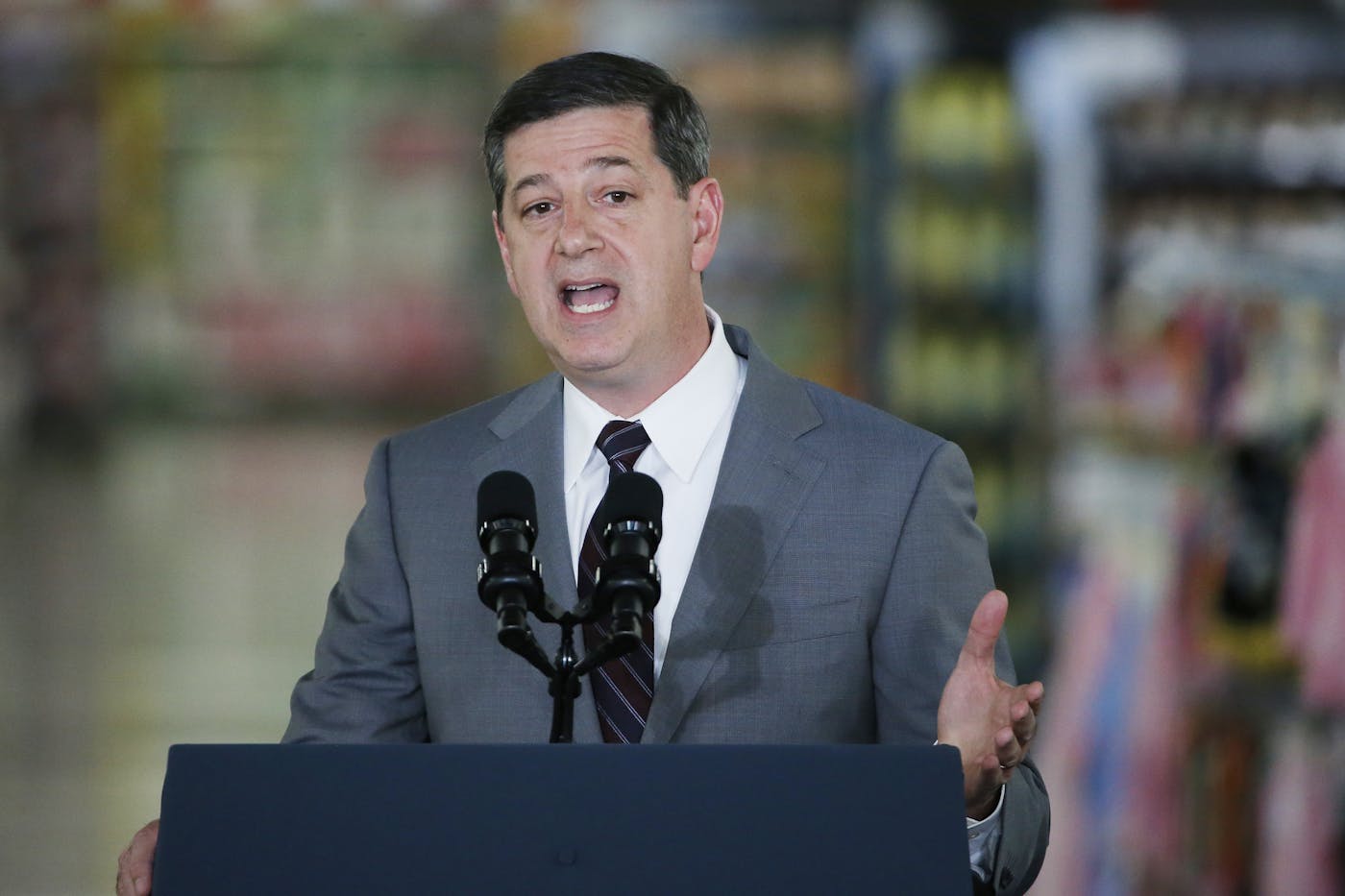
William S. Simon, retired CEO and president, Walmart U.S. (2010–2014)
Simon stepped down as CEO of Walmart’s domestic operations following a period of slow sales. He currently serves as a senior adviser for the investment firm KKR.
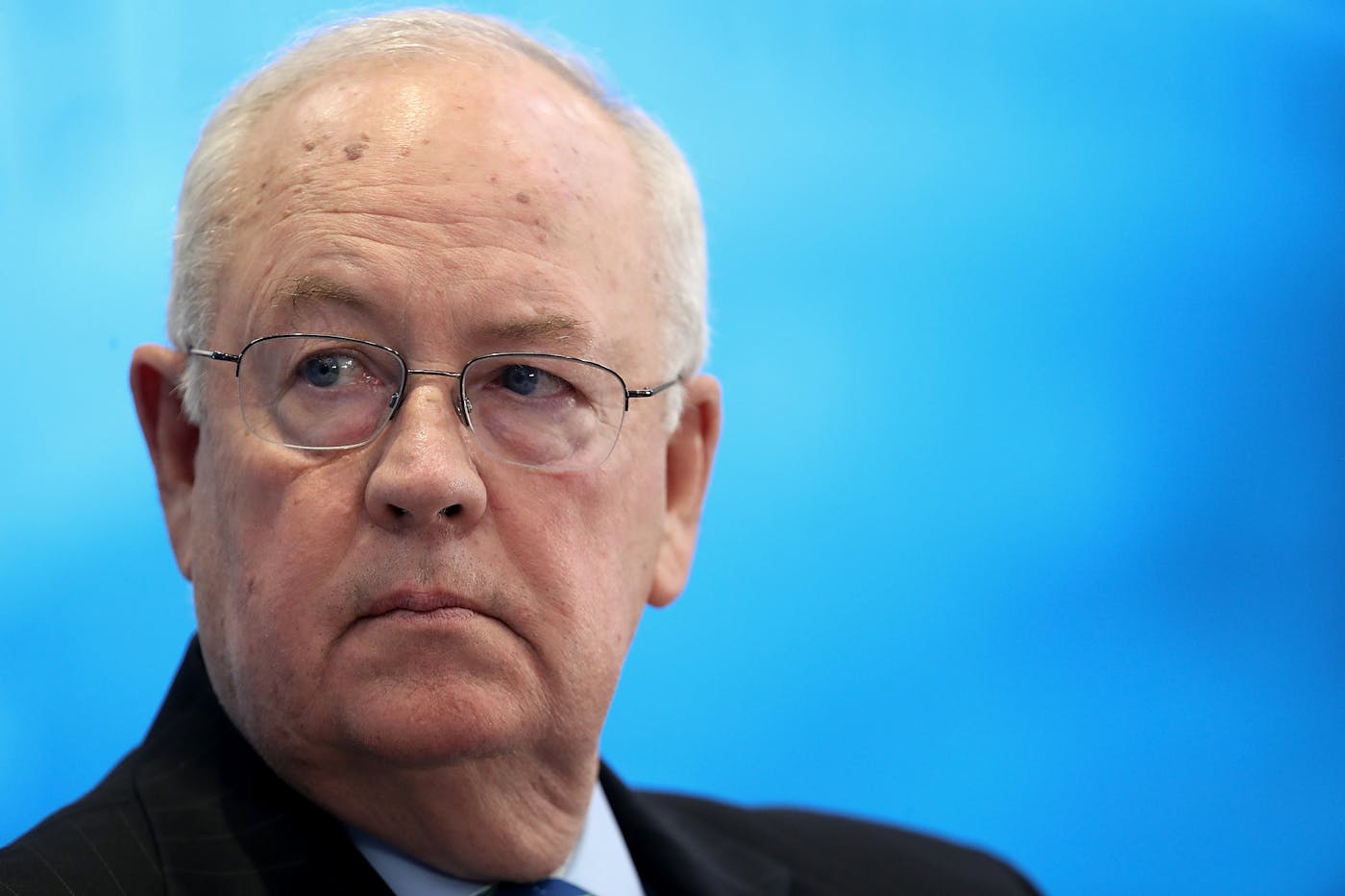
Kenneth Starr
Starr is best remembered for heading the Whitewater investigation of members of the Clinton administration. As a member of the CNP, Starr joins Donna Rice, who generated a scandal that put an end to former Senator Gary Hart’s presidential campaign in 1987.
The Council for National Policy’s core membership has been remarkably stable over the last 40 years, and founding members like Richard Viguerie and Morton Blackwell still play an active role. But there’s also a rotating cast of other characters, which appears to be pegged to the political climate of the moment. The February 2022 roster highlights two initiatives in particular: The first is the deadly Covid disinformation campaign, spearheaded by new member Simone Gold. She and her associates have been making millions of dollars from online prescriptions for bogus Covid cures and undermining vaccination and public health policies.
The second initiative has introduced new members to reinforce existing relationships. Lawson Bader cements the long-standing tie to the Koch Network, which has been a major force in the Donors Trust dark-money operation. Carrie Severino has long been a public voice for the campaigns to attack abortion and LGBT rights through the courts, which are now reaching fruition. Rachel Bovard enjoyed the rare privilege of joining the board of directors of CNP Action in her first year of membership. This indicates the emphasis the CNP places on the Conservative Partnership Institute, which is headed and run by leading members of the CNP and recently employed former White House chief of staff Mark Meadows. Finally, the CNP has long made a practice of hedging its bets. The Conservative Partnership Institute was recently cited in an Axios report as a prime architect for “Trump 2025,” Trump’s plans for demolishing the federal government should he win a second term. However, Mike Pence became a “dues-paying member” of the CNP this year as well, and there can be little doubt that there are active conversations with Ron DeSantis. The CNP’s leaders have made it clear that their objective is not the personality, it’s the outcome.
Anne Nelson @anelsona
Anne Nelson is the author of Shadow Network: Media, Money, and the Secret Hub of the Radical Right. She has taught at Columbia University for over 20 years and is currently a research scholar at Columbia’s Saltzman Institute of War and Peace Studies.

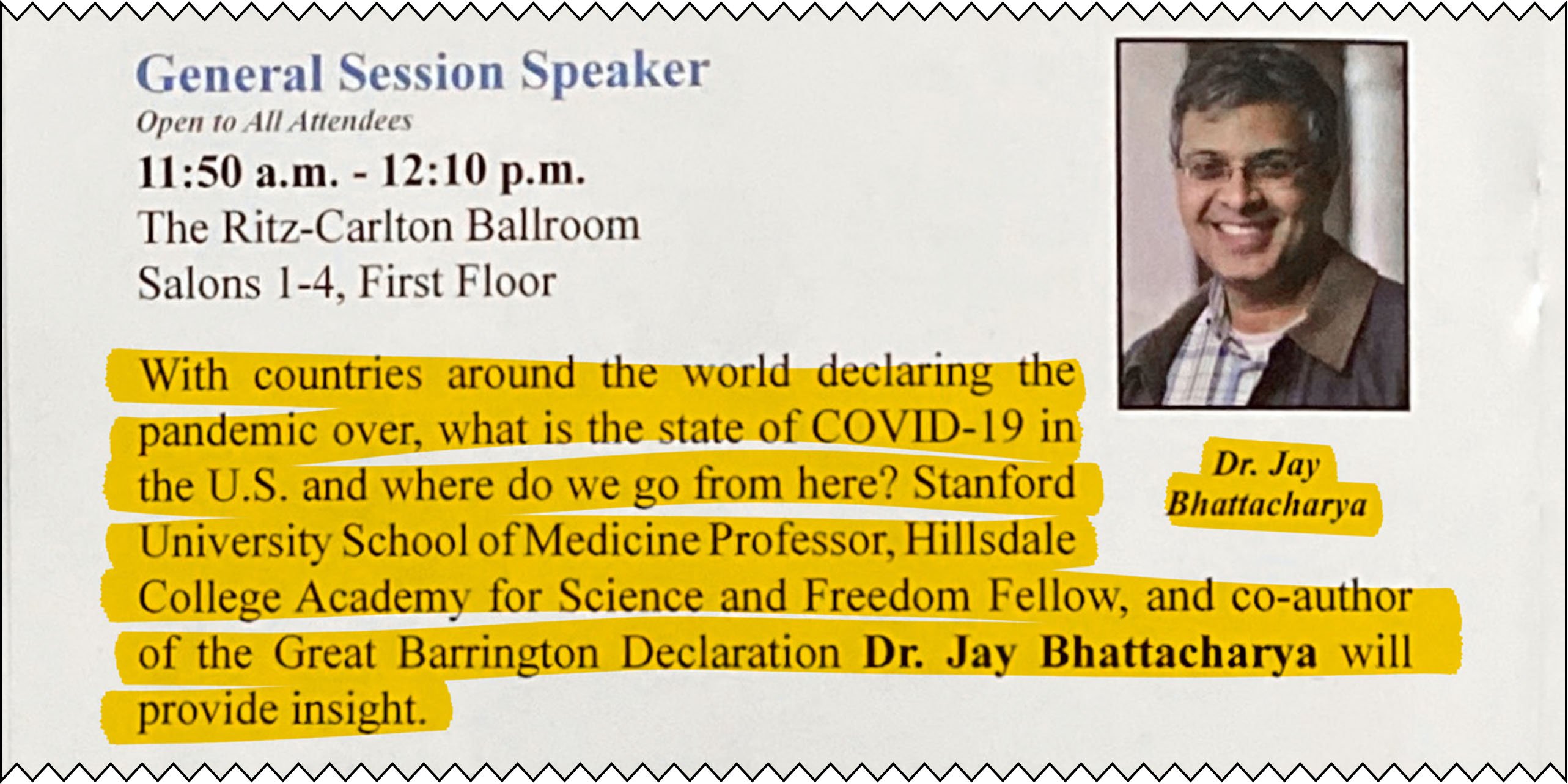





 J
J